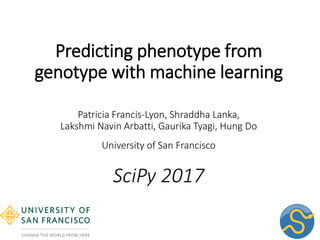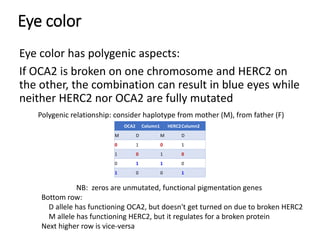The document discusses using machine learning to predict phenotypes from genotypes, particularly focusing on traits with significant genetic components like eye color. It outlines the methodology, including data sources, feature selection, and machine learning techniques to analyze SNPs, ultimately achieving high prediction accuracy. The approach emphasizes interpretability of results by detecting important SNPs and elucidating relationships between them, with a potential application to human disease risk assessments.







![Tools
• Human genomic data from OpenSNP,
mostly originating from 23andme and
Ancestry.com. Full dataset ~1.5 TB.
Our dataset of 830 people : 56 GB
• Information on millions of SNPs from dbSNP in .vcf
format - applicable to any human trait: 206 MB
• Python : Numpy, Pandas, Scikit-learn
• R (may use from Python with rpy2)
SNP FAQ Archive [Internet]
SNP file from dbSNP in .vcf format](https://image.slidesharecdn.com/predictphenofromgenoml-170721205759/85/Predicting-phenotype-from-genotype-with-machine-learning-8-320.jpg)









![Decision Tree Confusion
Matrix Comparison
Training set Test set
234 42 122 15
24 258 14 125
Decision Tree
Sensitivity: 0.899
Specificity: 0.891
Accuracy: 0.895
Sensitivity: 0.915
Specificity: 0.848
Accuracy: 0.882
param_grid={"criterion": ["gini", "entropy"],
"min_samples_split": [.01, .015, .02, .025],
"max_depth": [None, 4, 5],
"min_samples_leaf": [.0025, .005, .01,.015],
"max_features":[.3,.4,.5,]
}
To avoid overfitting,
hyperparameters were tuned
using cross validation grid
search on the training set](https://image.slidesharecdn.com/predictphenofromgenoml-170721205759/85/Predicting-phenotype-from-genotype-with-machine-learning-18-320.jpg)









